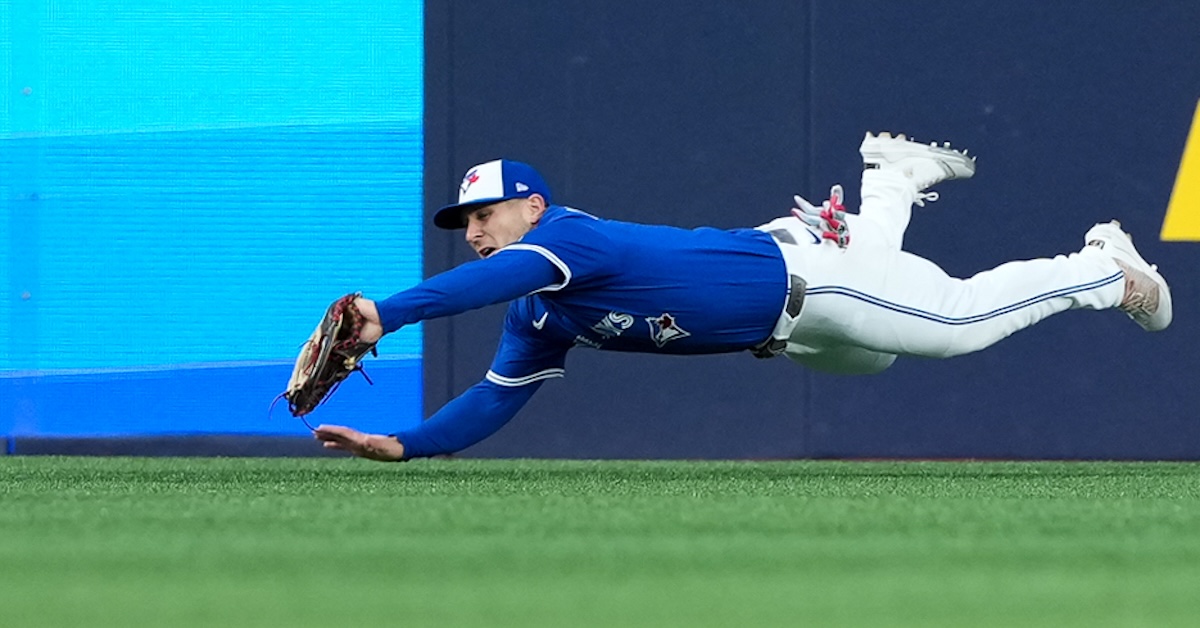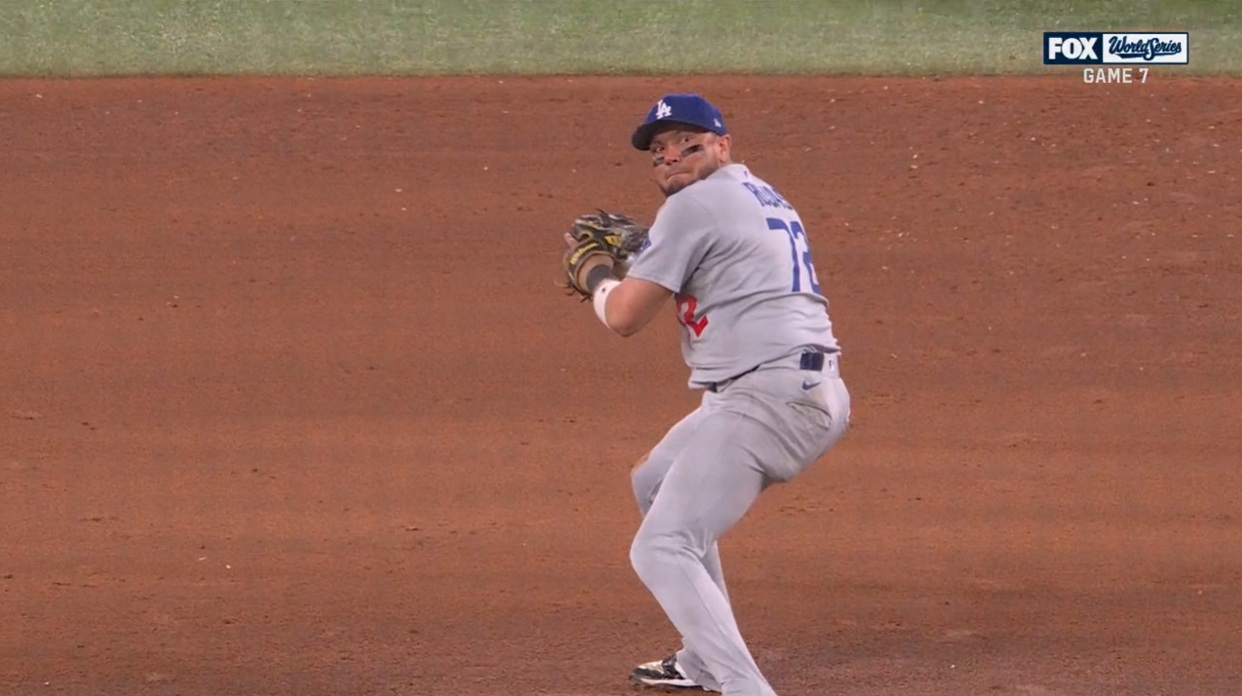Daulton Varsho Was Everywhere

I’m still coming down from the high of what I think we can all agree was a terrific World Series. It’ll go down as one of the best of the 21st century; it had star power, shocking twists, unlikely heroes, the whole nine yards. The guys who plotted out the ludicrously dramatic football depicted in Friday Night Lights are probably like, “Guys, cool it, you’re pouring it on too thick.”
The last game and a half especially, I was genuinely stressed out over the outcome, which is not something that usually happens when I have neither a partisan dog in the fight nor the obligation to write off the game.
A couple days out, I find myself experiencing an emotion I didn’t expect: I’m going to miss this Blue Jays team. They were a blast to watch. I don’t think I’ve ever seen a star player put his team on his back the way Vladimir Guerrero Jr. did this October. Not in baseball, at least, and certainly not a position player. I lived and died with each pained stagger taken by Bo Bichette and George Springer. Having seen Trey Yesavage pitch in college, his breakout took me less by surprise than most, but it was no less thrilling as a result.
Even the Jays’ detrimentally aggressive baserunning — which was their ultimate undoing — only made me like them more. Baseball is so optimized these days, so frequently homeworked into predictability, that it’s hard not to admire a team that’s unafraid to risk it all.
No one should be surprised that Sam Miller was able to describe the situation more incisively and succinctly than I have.
If I ever write up an all-time Played Their Asses Off leaderboard, the 2025 Blue Jays will be way up toward the top, and maybe the pull quote.
— Sam Miller (@sammillerbb.bsky.social) November 1, 2025 at 11:07 PM
In case you can’t tell, I love a charismatic runner-up, and I worry that as time passes, history will only remember so much of what made these Blue Jays so compelling. So I want to plant a historical marker for a guy who exemplified what I found so compelling about them: Daulton Varsho.
Varsho wasn’t one of Toronto’s biggest offensive contributors. He had some memorable contributions, to be sure. He went 4-for-5 with two dingers in the ALDS clincher against the Yankees, and it was his fourth-inning home run in Game 1 of the World Series that broke Blake Snell’s air of invincibility and announced that the underdog Blue Jays would not go quietly.
But overall, Varsho posted a wRC+ of 97, and among the 65 players who batted at least 20 times during this postseason, he was 59th in WPA. It didn’t help that he went 0-for-9 across Games 6 and 7 of the World Series. In fact, it was his sedate grounder to second with the bases loaded in the ninth inning of Game 7 that led to two days (and counting) of second-guessing Isiah Kiner-Falefa’s baserunning decisions.
You remember, the one where Miguel Rojas almost fell over while fielding the ball with the World Series-winning run on third, leading to this incredible “Oh, crap” face.

Nevertheless, I’ll give Varsho one of the highest compliments I can pay an athlete: He was a total pest. A menace. I don’t want to play up the grinder stereotype too much for the son of a former big league player and coach, who’s named after a catcher and who himself came up as a mid-major college catching prospect before transforming into a Gold Glove outfielder… but you get the picture.
The Dodgers kicked the crap out of Milwaukee in the NLCS, but there were moments in which the Brewers could’ve seized the initiative. Specifically, by letting a command-agnostic Dodger pitcher plunk them. Brewers second baseman Brice Turang found himself in the unusual position of having to account for not wearing a Blake Treinen offering in Game 1 of the NLCS, when doing so would’ve forced in the tying run.
No problem for Varsho, who got hit by only one pitch in 271 regular-season plate appearances in 2025. He got plunked twice in seven World Series games, including a Game 1 body shot from Snell that chased the two-time Cy Young winner and set the stage for a nine-run sixth inning.
It’s Canada. We got ice.
But it’s on defense where Varsho stood out most. Varsho made 49 putouts this postseason, 11 more than any other outfielder. Admittedly, that’s the result of opportunity; because the Blue Jays played two seven-game series, and the Dodgers shook up their outfield midstream, Varsho played 21 more innings than any other outfielder. Julio Rodríguez made 38 putouts in 12 games; Pete Crow-Armstrong made 24 in just eight games.
But some of Varsho’s were pretty rad. I love commemorating the end of the season with a ranked list, so here are the six best defensive actions of the postseason for Varsho.
No. 6: Hop, Skip, and a Jump
Varsho didn’t rob any home runs this postseason. Not that you’d expect him to do so at 5-foot-8. But this catch is a great illustration of Varsho’s ability to read the ball off the bat. Some outfielders get their range from sheer foot speed, and/or chase it down at a constant closing rate. Varsho reacts to the crack of the bat and scampers as fast as his little legs will go in the direction the ball is hit, slowing down only as he’s arriving at his eventual destination.
No. 5: The Smooth Operator
Varsho was relatively quiet defensively in Toronto’s first two rounds, but he was all over the place in the World Series. He made five putouts in Game 3 — all in the eighth inning or later — and then three more in the first five innings of Game 5, then this sliding grab of a sinking Will Smith liner, then another catch later in the inning. You start to understand how one would get sick of seeing this guy.
No. 4: Had It All the Way
This is a great read and a great break at a ball hit in front of him; line drives like this can sometimes be tricky to judge. Varsho could’ve gone to this ball more directly and caught it with two hands on the dead run. Instead, he played it one-handed with an insouciant little slide at the end.
No. 3: There, but for Taller Turf, Go I
This is the most spectacular catch of Varsho’s by far. He plucked the ball from the air just a couple inches from the ground, if that. Not a second to spare. Nevertheless, I have to mark it down a spot or two because Varsho made a rare bad read, breaking back on a ball that would ultimately end up in front of him.
No. 2: Going Horizontal in Game 7
This catch, a flying, diving grab to rob Teoscar Hernández of a hit, looked at the time like it could be decisive. A run scored on the play — Varsho’s throwing shoulder has been in some degree of desperate disrepair for more than a year, but I don’t think anyone short of Roberto Clemente could get up from a prone position to throw out a tagging runner at the plate. Had Varsho played it on a hop, at least one run would’ve scored, maybe two, and the Dodgers would’ve had the conga line intact. Had he missed this catch, the ball probably would’ve gone most of the way to the wall, leaving Hernández standing on second or third, with the bases otherwise clear and the game tied with one out.
Instead, Guerrero made an equally spectacular diving stop on a Tommy Edman liner to end the inning and limit the damage to a run. Craig Calcaterra called it “a team of destiny inning,” and he was right to do so. The Jays had just bloodied Shohei Ohtani’s nose half an inning before, and had Varsho and Guerrero not made these two diving stops, the Dodgers could’ve paid them back with interest and held a multi-run lead going into the bottom of the fourth.
No. 1: The Game 3 Extra-Inning Quadrilogy
This is actually four plays in one, with only one of them being anything resembling spectacular out of context, but it really sums up Varsho’s postseason for me.
Out of the 49 catches Varsho made in the outfield, 15 of them resulted in him putting one or both feet on the warning track. That’s 15 times the batter got all or most of the ball, leaving open the non-trivial possibility that when the broadcast changed camera angles, we were going to watch the ball fly into the seats. And instead of getting the most impactful play possible, what we got was Varsho trotting over to retire the batter.
This happened to the Dodgers a lot. Freddie Freeman hit 18 fly balls across three rounds of the playoffs. Two of them left the yard, two others went for doubles, and Varsho caught nine of the other 14. Five of those nine, Varsho caught on the warning track.
During the marathon Game 3, that legendary, definitive game, Varsho tracked down a warning track fly ball that came off the bat at 100 mph or more four innings in a row. Listen to the crowd in these videos. He got Freeman to end the 13th with a runner on second.
The very next Dodger hitter was Smith, who was so certain he’d won the game that he did a Barry Bonds-style bat drop-and-stare combo. Will Smith! Not usually one given to showboating, but he’s not made of stone — every hitter on a major league roster would pimp a walk-off no-doubter in the World Series. Fox announcer Joe Davis was certainly convinced that’s what he was calling.
But no, Varsho went right up to the wall and plucked the ball out of the air.
Freeman got another shot with two out in the 15th; I don’t think this ever realistically looked like it was going out, but it absolutely looked like a double in the gap.
Two-thirds of the Earth’s surface is covered by water, etc., etc.
In the 16th inning, it was Hernández’s turn again.
At this point, the Dodgers must’ve suspected that there was a force field or something. It’s Eric Lauer, for God’s sake (with all due respect), how have we not hit one out yet?
But every time, it was Varsho robbing them of the triumphant moment they’d stayed up all night for. At least until Freeman finally pushed one over the fence in the 18th.
If Guerrero dominated the playoffs by force of will, to an extent that’s usually only possible in basketball, Varsho was the Draymond Green to Guerrero’s Steph Curry. With less nut-punching. He was there to collect every stray ball, to fight for every rebound, to make every high-leverage defensive play. Five years from now, we probably will have forgotten all about Varsho’s contributions to the Blue Jays’ excruciating near-miss. But we can remember them for now.
Michael is a writer at FanGraphs. Previously, he was a staff writer at The Ringer and D1Baseball, and his work has appeared at Grantland, Baseball Prospectus, The Atlantic, ESPN.com, and various ill-remembered Phillies blogs. Follow him on Twitter, if you must, @MichaelBaumann.
I say this as about the highest compliment I can pay an OFer: he feels as inevitable as his former teammate, Kevin Kiermaier. It does feel like any fly ball in the middle of the field that doesn’t clear the fence is an out.